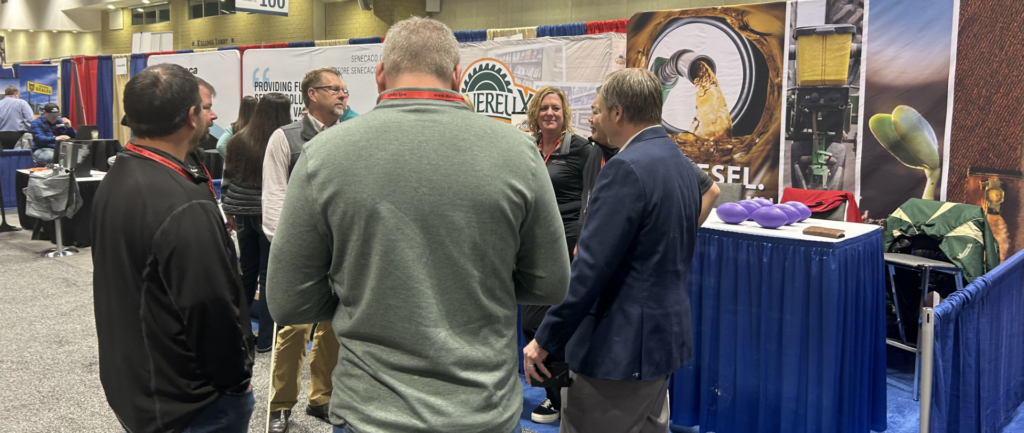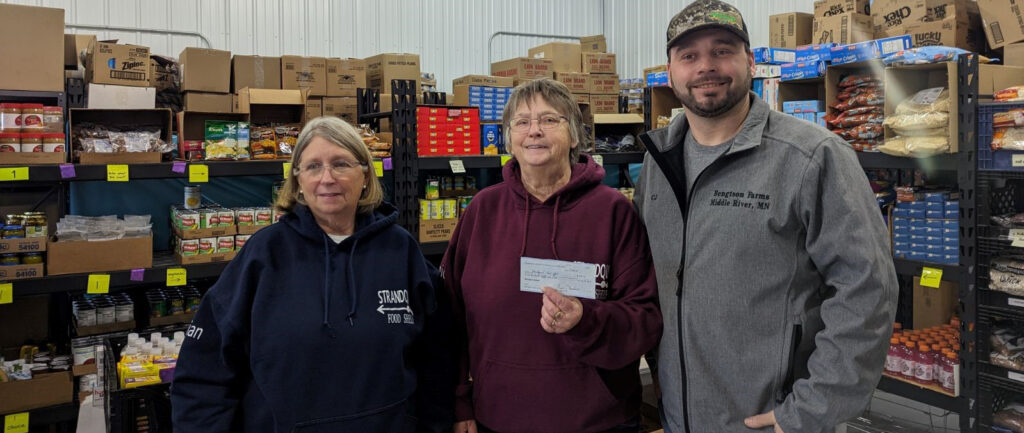This story was first featured in the July – August issue of Soybean Business. Click here to view the digital version of the magazine.
Checkoff investments are hardly overnight sensations. Successes are measured not in days or months, but years and decades. With some patience, the payoffs funded by checkoff investments can reap huge benefits for Minnesota’s 28,000 soybean farmers (see: biodiesel).
The roots of the non-GMO high oleic soybean trait began with a collaboration between a University of Missouri soybean breeder and a U.S. Department of Agriculture scientist. Minnesota’s involvement began in earnest with the mention of a handful of seeds kept on a shelf by Jim Orf, a renowned University of Minnesota breeder.
“When it comes to investing in research, the Council is intent on being careful and thinking long-term,” says MSR&PC Chair Patrick O’Leary. “There’s a niche market here that we can tap into, and if successful, we could have a very profound impact.”
Thanks in part to the foresight and leadership of past and present chairs, MSR&PC has the ingredients for a potential industry game-changer in the ground.
Big ideas require bigger thinkers to bring the biggest results. Enter TruSoya Non-GMO High Oleic Soybeans.
“We thought we should give this a whirl because non-GMO beans seem to be gaining more status, both statewide and nationally, and we’ve been trying to get high oleic off the ground in the U.S.” says past MSR&PC Chairman Keith Schrader. “If TruSoya pans out, all Minnesota farmers will reap a benefit.”
The steps that brought TruSoya’s Non-GMO High Oleic soybeans to fruition were shepherded by three intrepid MSR&PC chairs (Paul Simonsen, Schrader and O’Leary) over the course of four years. All three worked in succession to serve as sage stewards of checkoff investments.
“These chairs of the board were reviewing the books and projects, and they realized there was a lot more opportunity and potential left out there,” says Tom Slunecka, Minnesota Soybean’s CEO.
Now, the blood, sweat and years spent developing and investing in a new variety will soon pay dividends for the Council.
This growing season, Schrader, an MSR&PC director, and Simonsen contracted with MSR&PC’s seed development partner to grow small test acreages of TruSoya’s Non-GMO High Oleic variety on their family farms with hopes for a formal commercialization launch by 2020.
“I’m out in the field looking at it right now. It looks good – it needs to be sprayed in the next week or so,” Simonsen, a Renville County farmer, said in early June. “I’m excited to seeing how it’s going to do.”
Slunecka lauded Simonsen for encouraging the Council to tackle challenging but worthwhile projects during his tenure as chair. Simonsen, who retired as an MSR&PC director in 2016, is still pushing himself and other growers to maximize checkoff-funded research.
“When he was chair, Paul originally thought, ‘How do we get ideas out of the system and to the farm gate?’” Slunecka says. “That’s what it’s all about – did it actually impact farmers and reach the farm gate? Paul talked the talk, and now he’s walking the walk by taking a risk on those acres.”
The non-GMO variety, SOYLEIC™ soybeans, was made possible through a partnership with the Missouri Soybean Merchandising Council with funding through United Soybean Board. Checkoff-supported soybean breeders first identified the non-GMO high oleic trait on a research farm in Missouri.
Patents and licensing agreements opened the door to bring the technology to Minnesota. The trait was shared with University of Minnesota, where it was further bred and researched by Orf and University agronomy professor Aaron Lorenz. It was then sent to a lab at the University’s research plot in Chile for further breeding before the variety was shipped back to Minnesota in 2017.
Meanwhile, around 2014, Slunecka, Schrader and Simonsen helped form the nucleus for MSR&PC’s “high impact” task force, which focuses on innovative uses for soybeans that have been extensively researched and are nearing the commercialization stage.
“From the board members to the staff, we all had the same mindset: Let’s think outside the box,” says Schrader, who farms near Nerstrand, Minn.
When O’Leary, a Benson, Minn., farmer, was elected MSR&PC chair in 2017, the speed of the TruSoya project went into high gear and began taking clearer shape.
“Patrick has been very methodical in assuring transparency and reporting,” Slunecka says. “He has a strong desire to explain things to every checkoff farmer, and that’s been a benefit to our entire organization.”
Were it not for the vision of the high impact team, Slunecka doubts the TruSoya vision would’ve gone past the initial brainstorming stage.
“Because these three men decided to send an envoy to look for technology, they were able to put the non-GMO trait to work with the high impact machine,” he says. “In their own way, they resurrected it.”
What’s unique about the formation of TruSoya is it’s almost entirely farmer owned, has full traceability, making it unique to commodity groups.
“The farmers basically own this all the way to the refinery,” Slunecka says. “We have the traceability, and that’s partly what’s going to make our oil stand out.”
MSR&PC’s Non-GMO launch is a rarity seldom seen outside of specialty crops.
“It’s far more complicated for a commodity group,” Slunecka says. “It can only happen whenever there’s tremendous value and identity.”
In it for the long haul
High oleic cooking oil, created with biotech traits, has already begun separating itself from the pack as a more healthy cooking oil. The non-GMO variety is 70 percent high oleic but also has an ideal high linolenic content, which meets consumers’ needs for more healthy foods.
It has zero trans-fat, less absorption, 30 percent less saturated fat than conventional soybean oil, and an ideal omega-6 to omega-3 fatty acid ratio. USDA and health organizations around the world have recently been stating the importance of omega 3 fatty acids in improving cardiovascular health.
High oleic’s longer fryer life (double the length compared to commodity soybean frying oil) also makes the soybean oil a boon for restaurants.
“The high oleic property is a solution to the trans- fat problem that snuck up on the soybean industry 10, 12 years ago,” Schrader says. “This is a more stable oil ingredient.”
Non-GMO soybean premiums present profitability opportunities for growers by increasing demand by an estimated 50-to-75 cents per-bushel. Global high oleic demand is forecasted to grow by 3.5 million metric tons by 2020.
“The farmer doesn’t benefit unless there’s a demand downstream, and that’s where we can get involved and try to create demand,” Schrader says. “It’s really a grassroots effort to build demand with food companies and manufactures that would value this product.”
A small test acreage was also grown in Minnesota in 2017; in order to assure quality oil testing in small quantities, those beans were crushed at Texas A&M this June and were refined in July. TruSoya beans were planted in a handful of locations in Minnesota in 2018, and additional bushels will be crushed this summer. The goal is to yield enough TruSoya seeds to have 10,000 acres planted in 2019 and 100,000 acres by 2020.
“If we can create the demand, it’s going to be a great product,” says Cole Trebesch, an MSPR&PC director and high impact action team member. “It’s really been a team effort all the way around, and that starts at the top with our leadership team.”
MSR&PC and NovelSoy, its newly-formed seed licensing company, plan to subcontract with Legend Seeds – beyond the seed amplification agreement for 2018 – to grow the TruSoya variety commercially.
“Legend is a strong, regional, family-owned brand with a lot of experience in non-GMOs,” Simonsen says. “They’re willing to try new things, which makes this a perfect partnership.”
Because a commercial license agreement is still pending, MSR&PC has remained cautious and prudent with the TruSoya rollout. 2018 will focus on introducing the NovelSoy TruSoya brands, building demand and further improving TruSoya’s yield and consistency. Learn more about TruSoya at the newly-launched trusoya.com.
“Commercialization is the hardest step in putting all the pieces together in this process,” Slunecka says. “It’s more difficult than financing or the basic research, but we really feel we are taking the right steps to benefit farmers in creating a product that consumers will demand.”
All checkoff investments carry inherent risks. The rewards, however, can make the endeavor worth the toil.
TruSoya has been worth the wait.
Tags: high oleic






